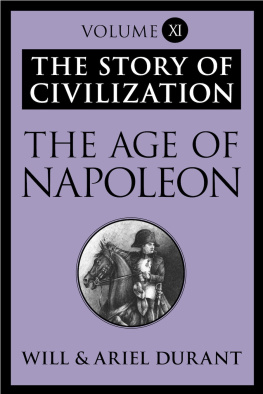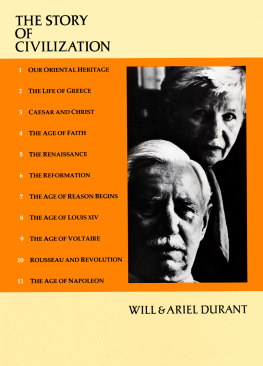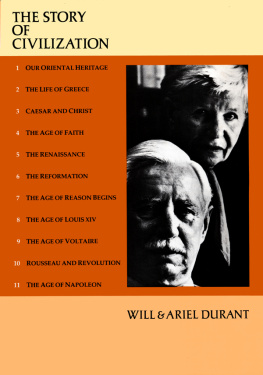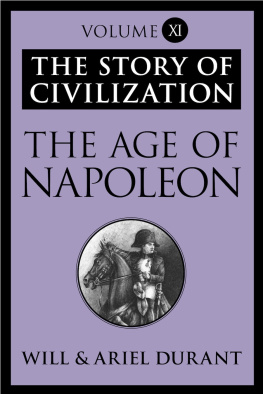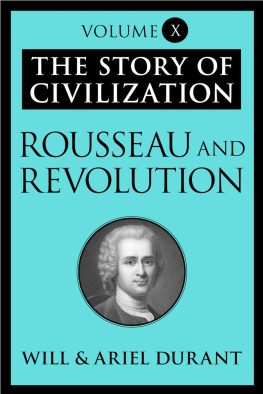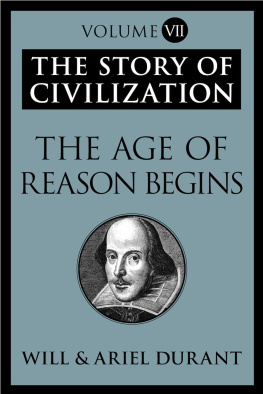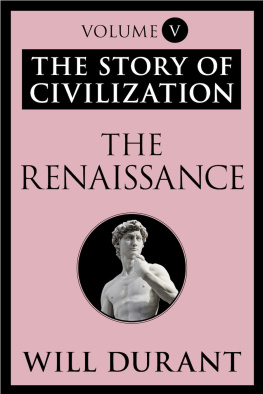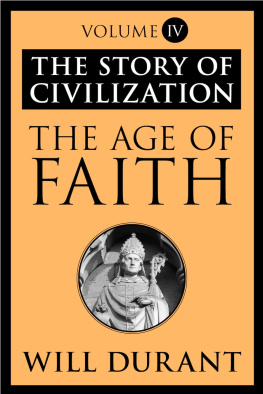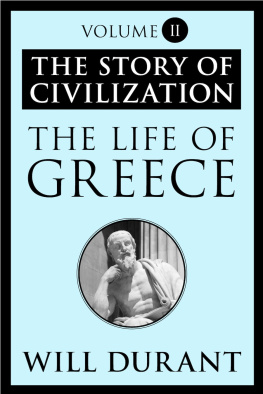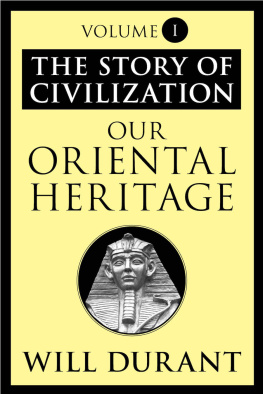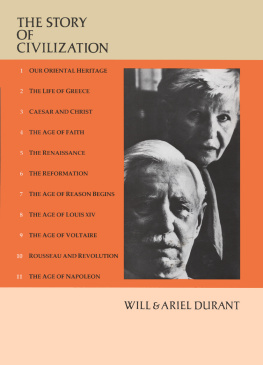Will Durant - The Story of Civilization Volume XI: The Age of Napoleon
Here you can read online Will Durant - The Story of Civilization Volume XI: The Age of Napoleon full text of the book (entire story) in english for free. Download pdf and epub, get meaning, cover and reviews about this ebook. year: 0, publisher: Simon & Schuster, genre: History. Description of the work, (preface) as well as reviews are available. Best literature library LitArk.com created for fans of good reading and offers a wide selection of genres:
Romance novel
Science fiction
Adventure
Detective
Science
History
Home and family
Prose
Art
Politics
Computer
Non-fiction
Religion
Business
Children
Humor
Choose a favorite category and find really read worthwhile books. Enjoy immersion in the world of imagination, feel the emotions of the characters or learn something new for yourself, make an fascinating discovery.
- Book:The Story of Civilization Volume XI: The Age of Napoleon
- Author:
- Publisher:Simon & Schuster
- Genre:
- Year:0
- Rating:4 / 5
- Favourites:Add to favourites
- Your mark:
- 80
- 1
- 2
- 3
- 4
- 5
The Story of Civilization Volume XI: The Age of Napoleon: summary, description and annotation
We offer to read an annotation, description, summary or preface (depends on what the author of the book "The Story of Civilization Volume XI: The Age of Napoleon" wrote himself). If you haven't found the necessary information about the book — write in the comments, we will try to find it.
The Story of Civilization Volume XI: The Age of Napoleon — read online for free the complete book (whole text) full work
Below is the text of the book, divided by pages. System saving the place of the last page read, allows you to conveniently read the book "The Story of Civilization Volume XI: The Age of Napoleon" online for free, without having to search again every time where you left off. Put a bookmark, and you can go to the page where you finished reading at any time.
Font size:
Interval:
Bookmark:

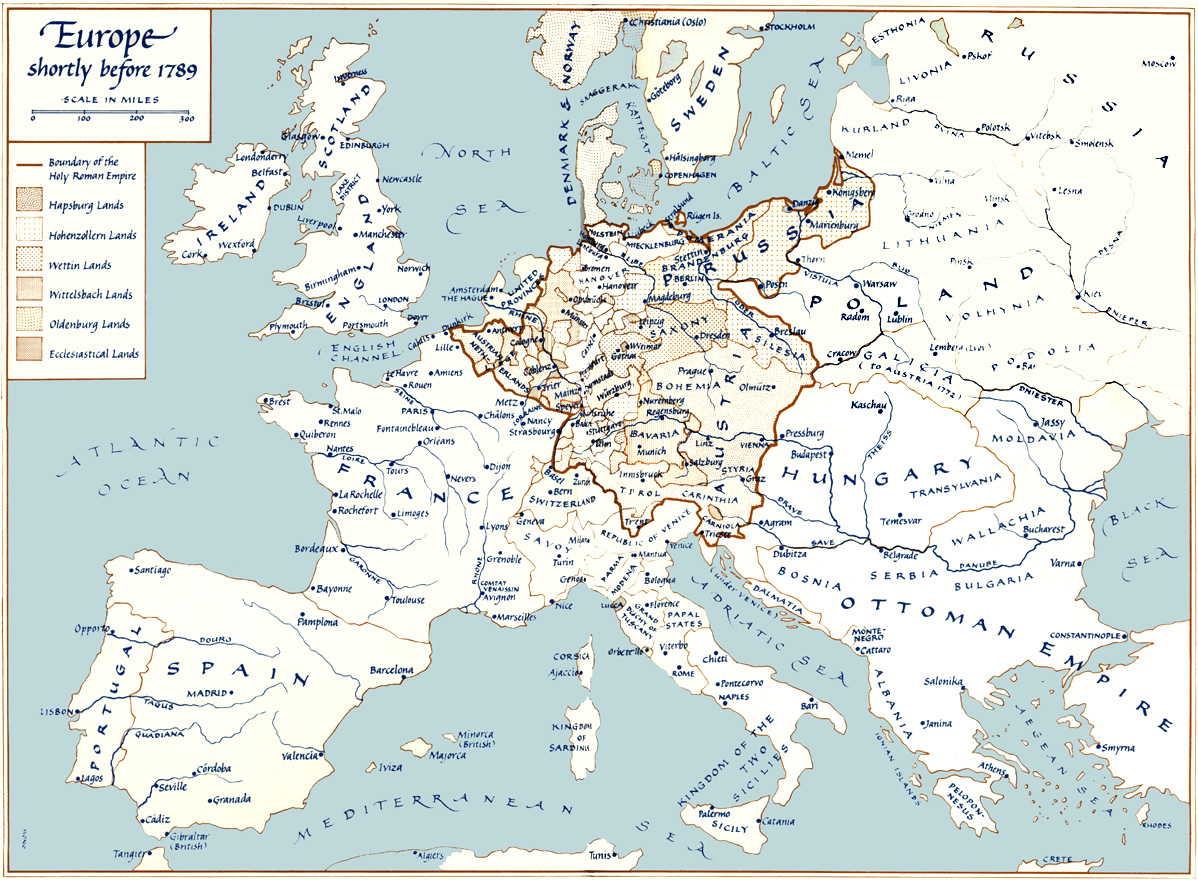
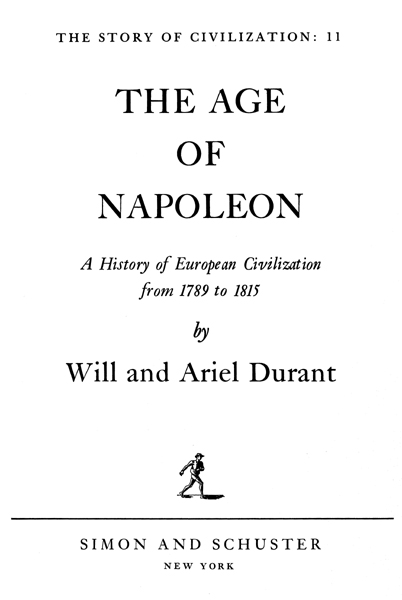
TO ETHEL
By the middle of the twentieth century, says the Encyclopaedia Britannica (XVI, Ioa), the literature on Napoleon already numbered more than 100,000 volumes. Why add to the heap? We offer no better reason than to say that the Reaper repeatedly overlooked us, and left us to passive living and passive reading after 1968. We grew weary of this insipid and unaccustomed leisure. To give our days some purpose and program we decided to apply to the age of Napoleon (17891815) our favorite method of integral historyweaving into one narrative all memorable aspects of European civilization in those twenty-seven years: statesmanship, war, economics, morals, manners, religion, science, medicine, philosophy, literature, drama, music, and art; to see them all as elements in one moving picture, and as interacting parts of a united whole. We would see Prime Minister William Pitt ordering the arrest of author Tom Paine; chemist Lavoisier and mystic Charlotte Corday mounting the guillotine; Admiral Nelson taking Lady Hamilton as his mistress; Goethe foreseeing a century of events from the battle of Valmy; Wordsworth enthusing over the French Revolution, Byron over the Greek; Shelley teaching atheism to Oxford bishops and dons; Napoleon fighting kings and imprisoning a pope, teasing physicians and philosophers, taking half a hundred scholars and scientists to conquer or reveal Egypt, losing Beethovens dedication to the Eroica for an empire, talking drama with Talma, painting with David, sculpture with Canova, history with Wieland, literature with Goethe, and fighting a fifteen-year war with the pregnable but indomitable Mme. de Stal. This vision roused us from our septua-octo-genarian lassitude to a reckless resolve to turn our amateur scholarship to picturing that exciting and eventful age as a living whole. And shall we confess it?we had nurtured from our adolescence a sly, fond interest in Napoleon as no mere warmonger and despot, but as also a philosopher seldom deceived by pretense, and as a psychologist who had ceaselessly studied human nature in the mass and in individual men. One of us was rash enough to give ten lectures on Napoleon in 1921. For sixty years we have been gathering material about him, so that some of our references will be to books once helpful and now dead.
So here it is, a labor of five years, needing a lifetime; a book too long in total, too short and inadequate in every part; only the fear of that lurking Reaper made us call a halt. We pass it on, not to specialist scholars, who will learn nothing from it, but our friends, wherever they are, who have been patient with us through many years, and who may find in it some moments illumination or brightening fantasy.
W ILL AND A RIEL D URENT
First of all, to our daughter, Ethel Durant Kay, who not only typed the manuscript immaculately, but often improved it with corrections and suggestions. She has been a patient and helpful companion to us at every stage of our enterprise.
To our dear friends Arthur Young and Gala Kourlaeff, who lent us precious books from their private collections.
To the Los Angeles Public Library, and more directly to its Hollywood Branch and the ladies at its reference desk, and especially to Mrs. Edith Cruikshank and Mrs. Elizabeth Fenton.
To J. Christopher Herold, whose books on Napoleon and Mme. de Stal have been a light and a treasure to us; and to Leslie A. Marchand, whose masterly three-volume Byron has moderated, with its wealth of information, a Byronic addiction already passionate in 1905, when WD prayed God to release the crippled poet from hell.
To Vera Schneider, who brought to the months-long task of copy editing all the scope and precision of her scholarship. Our book has profited immensely from her work.
And to our dear friend Fernand, Comte de Saint-Simon, who gave so much of his time to guiding us to Napoleoniana in Paris, Versailles, and Malmaison.
All in all, in life and history, we have found so many good men and women that we have quite lost faith in the wickedness of mankind.
NOTE
In excerpts, italics for emphasis are never ours unless so stated.
Certain especially dull passages, not essential to the story, are indicated by reduced type.
No consistent formulation is possible: coins bearing the same names now as then usually bought, two hundred years ago, much more than now, but sometimes less. History is inflationary, if only through repeated debasements of the currency as an old way of paying governmental debts; but the notion that goods cost less in the past than now is probably the enchantment of distance; in terms of labor required to earn the money to buy them they generally cost more. By and large, allowing for many exceptions and national variations, we may equate some European currencies of 1789 with United States currencies of 1970 as follows.
crown, $6.25
ducat, $12.50
florin, $2.50
franc, $1.25
groschen, cent
guilder, $5.25
guinea, $26.25
gulden, $5.00
kreuzer, cent
lira, $1.25
livre, $1.25
louis dor, $25.00
mark, $1.25
pound, $25.00
shilling, $1.25
sou, 5 cents
thaler, $5.25
T HE page numbers following the captions refer to discussions in the text of the subject or the artist, or sometimes both.
Part I. This section follows page 156
Part II. This section follows page 528
THE FRENCH REVOLUTION
178999
The Background of Revolution
177489
F RANCE was the most populous and prosperous nation in Europe. Russia in 1780 had 24 million inhabitants, Italy 17 million, Spain 10 million, Great Britain 9 million, Prussia 8.6 million, Austria 7.9 million, Ireland 4 million, Belgium 2.2 million, Portugal 2.1 million, Sweden 2 million, Holland 1.9 million, Switzerland 1.4 million, Denmark 800,000, Norway 700,000, France 25 million. Paris was the largest city in Europe, with some 650,000 inhabitants, the best-educated and most excitable in Europe.
The people of France were divided into three orders, or classes (tats states or estates): the clergy, some 130,000 souls; the nobility, some 400, 000; and the Tiers tat, which included everybody else; the Revolution was the attempt of this economically rising but politically disadvantaged Third Estate to achieve political power and social acceptance commensurate with its growing wealth. Each of the classes was divided into subgroups or layers, so that nearly everyone could enjoy the sight of persons below him.
The richest class was the ecclesiastical hierarchycardinals, archbishops, bishops, and abbots; among the poorest were the pastors and curates of the countryside; here the economic factor crossed the lines of doctrine, and in the Revolution the lower clergy joined with the commonalty against their own superiors. Monastic life had lost its lure; the Benedictines, numbering 6,434 in the France of 1770, had been reduced to 4,300 in 1790; nine orders of religious had been disbanded by 1780, and in 1773 the Society of Jesus (the Jesuits) had been dissolved. Religion in general had declined in the French cities; in many towns the churches were half empty; and among the peasantry pagan customs and old superstitions competed actively with the doctrines and ceremonies of the Church. The nuns, however, were still actively devoted to teaching and nursing, and were honored by rich and poor alike. Even in that skeptical and practical age there were thousands of women, children, and men who eased the buffets of life with piety, fed their imaginations with tales of the saints, interrupted the succession of toilsome days with holyday ritual and rest, and found in religious hopes an anodyne to defeat and a refuge from bewilderment and despair.
Font size:
Interval:
Bookmark:
Similar books «The Story of Civilization Volume XI: The Age of Napoleon»
Look at similar books to The Story of Civilization Volume XI: The Age of Napoleon. We have selected literature similar in name and meaning in the hope of providing readers with more options to find new, interesting, not yet read works.
Discussion, reviews of the book The Story of Civilization Volume XI: The Age of Napoleon and just readers' own opinions. Leave your comments, write what you think about the work, its meaning or the main characters. Specify what exactly you liked and what you didn't like, and why you think so.

